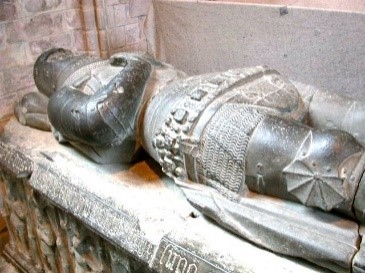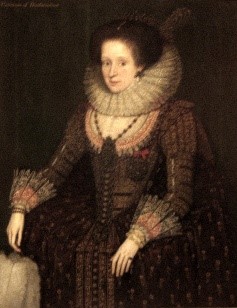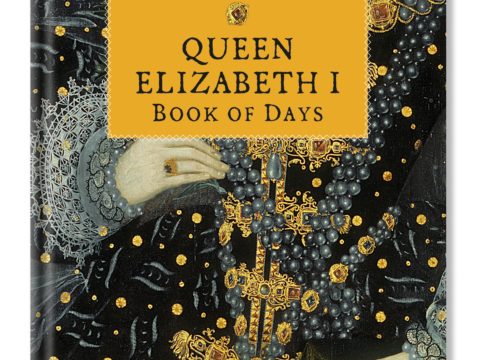Scottish Peers
Chapter 4 : Earls (Buchan - Dunfermline)
There were two distinct types of Earldoms – those which originated from the Mormaers of the ancient kingdoms that made up Scotland north of the Firth of Forth, and those granted by Kings, although by the late fifteenth century the term Earl was used for both. The old mormaerdoms were ‘comital’ that is, they relate to specific geographic territories and were not just titles. Later earldoms might be comital, or just titular. The earldoms below are only those which were created prior to 1625.
Buchan
The ancient mormaerdom passed through Marjory, Countess (or ban-mormaer) of Buchan to her husband, Sir William Comyn. The Comyns were forfeited for opposition to Robert the Bruce (r. 1306 – 1329). The earldom was recreated for James Stewart, second son of Joan Beaufort, Dowager Queen of Scots and her second husband, Sir James Stewart of Lorn. On the death of the 3rd Earl in 1551, the title was inherited by his grand-daughter, Christian, and then by Christian’s daughter, Lady Mary Douglas (niece of Lord James Stewart, 1st Earl of Moray, Regent to James VI). She and her husband, Lord James Erskine, were regranted the title, but in tail male only, with remainder to his heirs, rather than hers. The current earl, the 17th, is descended from Countess Mary’s brother-in-law.

Caithness
In early times, Caithness was
associated with Orkney, which formed part of the Kingdom of Norway. William
Sinclair, 3
rd Earl of Orkney (1410 – 1484) exchanged some of his
lands at Nithsdale for the Earldom of Caithness. When James III of Scotland
became the ruler of Orkney, Sinclair lost his Norwegian earldom, and retained
the Scottish title of Caithness. The 2
nd Earl died at Flodden, and the 3rd
in 1529. The Earls kept a low profile during the sixteenth century. The current
holder of the title is the 20
th Earl, a direct descendant of William
Sinclair and Chief of Clan Sinclair.
Carrick
The Mormaers of Carrick spent a good deal of time playing
off the English and Scottish Kings against each other, whilst promoting their
own power in south-west Scotland. In 1256, Marjorie, Ban-mormaer of Carrick,
married Robert Bruce, sixth Lord of Annandale. She was succeeded by her son
Robert ‘the Bruce’, who became King Robert I of Scotland. Although the title
was granted at various times to brothers or sons of Scottish kings, it finally
merged permanently with the Crown in 1406. In accordance with an Act of the
Scottish Parliament of 1469, the title is granted to the eldest son of the
monarch. It is currently held by Prince Charles, Duke of Rothesay and Earl of
Carrick.
Cassilis
The earldom of Cassilis was created in 1502 by King James IV for his Privy Councillor David Kennedy, 3rd Lord Kennedy. The 1st Earl was killed at the Battle of Flodden and was succeeded by his son. The 3rd Earl was taken prisoner by the English at the Battle of Solway Moss in 1542. During his captivity in England Cassilis became a supporter of the Reformed Faith, and agreed, whether willingly or not, to support Henry VIII’s policy of uniting the countries by forcibly marrying Mary, Queen of Scots to his son, later Edward VI.
Cassilis and the other hostages were known in England as the ‘Assured Lords’ and were sent back to Scotland to promote a pro-English policy. During the 1550s Cassilis served as Treasurer of Scotland and an Extraordinary Lord of Session. In 1558 he was one of the eight Scottish Parliamentary Commissioners who attended the marriage of Queen Mary to the Dauphin François of France. The Commissioners refused to grant François the Crown Matrimonial (by which had Mary died childless before him, François would have inherited her crown). Cassilis and two others of the Commissioners died on the same day in France, allegedly of poison in revenge for this refusal.
In a dreadful example of the sort of feuding endemic amongst the Scottish Lords, the 4th Earl of Cassilis captured a rival, Allan Stewart, the Commendator of Crossraguel, and tortured him by fire to persuade him to cede territory. Stewart was rescued by his brother-in-law, the Laird of Bargeny, but unsurprisingly, the incident led to a feud between the Kennedys of Cassilis and the Lairds of Bargeny. The Earl supported Queen Mary at the Battle of Langside, but following the defeat was reconciled to the King’s party, dying in a riding accident in 1576.
Like his father, the 5th Earl was Treasurer of Scotland, but, also like his father, was involved in feuds, raiding parties, and assassination of his rivals. His violence was so extreme that in 1604 he was put under house arrest for assaulting his wife: given that wife-beating in general hardly raised an eyebrow, it must have been a severe attack. He was succeeded by his nephew John, in 1616. The earldom was promoted to the Marquisate of Ailsa in 1831 which is held by David Kennedy, 9th Marquis.
Crawford
This earldom was created in 1398 by Robert II for Sir David Lindsay of Glenesk, who was his son-in-law. The 3rd Earl was Regent during the minority of James II. The 6th Earl was killed at Flodden. The 8th Earl, David, disinherited his son, Alexander, the Master of Crawford, for attempting to murder him. The title therefore passed to a distant cousin, David Lindsay of Edzell, who in turn bequeathed it back to the son of Alexander. The 11th Earl was involved in various intrigues during the reign of James VI and was imprisoned following a fracas in which his hereditary enemy, the Lord of Glamis, was killed.
He spent some time abroad, in company with the 6th Earl of Huntly, and, together with other Catholic nobles was involved in correspondence with Spain, related to that country’s intended invasion of England in 1588. He broke with Huntly after 1589, and, having been found guilty of treason for his part in bearing arms against the King, spent some time in prison before being released and restored to favour. He died in 1607, and was succeeded by his son, David, 12th Earl. The 12th Earl was ‘put to the horn’ (outlawed) for murder, but evaded punishment. Further criminal behaviour resulted in him being confined by his own family and he was succeeded by an uncle.
Dunfermline
The earldom of Dunfermline was a new title created for Alexander Seton, a younger son of the 7 th Lord Seton. The 1st Lord Seton, Sir William, was created a Lord of Parliament in 1371. The second, John, was probably the founder of the Seton Collegiate Church in East Lothian. His son, George, the Master of Seton, was killed fighting in the French army at the Battle of Verneuil before his father died, so the title passed to the 2 nd Lord’s grandson. George, the 3rd Lord, was involved in a number of diplomatic missions to England and to the Low Countries.
The 5th Lord, another George, was killed at the Battle of Flodden. He was survived by his widow, Lady Janet Hepburn, daughter of the 1st Earl of Bothwell, for 45 years. George, the 6th Lord Seton, was appointed as an extraordinary Lord of Session in 1542. Initially he supported the proposed marriage of the infant Queen Mary to Edward, Prince of Wales, however he was an ally of Cardinal Beaton, who firmly opposed the match. Seton had been appointed to guard the Cardinal following his arrest by the Regent Arran, but allowed him to escape. In 1548, Seton’s home, Seton Palace, and the Collegiate Church had been severely damaged by the English during the War of the Rough Wooing. By his second marriage to a French lady in waiting of Queen Marie of Guise, the 6 th Lord was the father of Mary Seton, one of the little girls chosen as companions to Mary, Queen of Scots, known to history as the ‘ four Marys’.
The 7th Lord Seton was appointed Provost of Edinburgh in 1557, a role not dissimilar to that of Lord Mayor of London during the same period. The Provost and his Council were responsible for management of the city. Seton, who was a committed Catholic, was faced with the problem of the growing dissent between Catholics and the increasing Protestant minority. When the Lords of the Congregation occupied Edinburgh in 1559, rioters attacked the Blackfriars and Greyfriars convents which Seton was unable to prevent. The Lords were expelled and Mass restored at St Giles but by October 1559 the Lords were again in control under a rival Council, headed by the Protestant Archibald Douglas of Kilspindie.
Seton supported Marie of Guise at the Battle of Leith, but after her death and the signing of the Treaty of Edinburgh by the Lords of the Congregation with Elizabeth I of England, he went to France. He returned the following year, shortly before the arrival of Queen Mary. Throughout Mary’s reign he was completely loyal to her and took as his motto UN DIEU, UN FOY, UN ROY, UN LOY (one God, one faith, one monarch, one law) which he had carved in stone at Seton Palace.
He supported Mary’s marriage to Darnley, and later to Bothwell. Captured at the Battle of Langside, he was saved from death by the Earl of Moray. He was one of the Queen’s Party besieged in Edinburgh Castle but, after it fell, he was permitted to go into exile in France. During the 1570s, he remained in contact with Mary, now in prison in England, and tried, by every means possible, to persuade either France or Spain to reinstate her. He returned to Scotland sometime before 1579 and, after the execution of the 4 th Earl of Morton in 1582, once more became involved in Government.
In 1583 Seton was sent on an embassy to France, reassuring the exiled Mary that the purpose was to renew the Auld Alliance. He remained in France for a couple of years, returning in 1585. He died the following year.

His younger son, Alexander, was also a devout Catholic, and during 1570s was educated in Rome. He returned with his father to Scotland and then accompanied the 7 th Earl on his diplomatic mission to France in 1583. He became a Privy Councillor to James VI and a Lord of Session, eventually becoming Lord President of the Court of Session. He became tutor to Prince Charles, younger son of James VI. He was a strong supporter of the union of the crowns and became Lord Chancellor of Scotland once James VI had departed south. He was created Earl of Dunfermline in 1604 and continued his solid service to the Crown. The earldom was forfeit in 1690 for the 4 th Earl’s support of the deposed King James VII & II.





